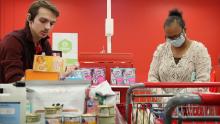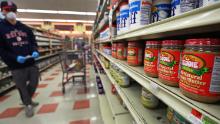[ad_1]
“Careless customers” are “probably the biggest threat” to workers right now, according to Marc Perrone, president of the United Food and Commercial Workers’ union. The union said 85% of its grocery store member workers reported that customers are not practicing social distancing in stores.
“Anything that reduces the need for interaction with the public and allows for greater physical distancing will ultimately better protect grocery workers,” said John Logan, professor and director of Labor and Employment Studies at San Francisco State University. “Shuttering stores and repurposing them for pickup and delivery only would be a positive step.”
Mike Houston, general manager of Takoma Park Silver Spring Co-op in Takoma Park, Maryland, decided to close his grocery store to the public in late March, when the state announced a shelter-in-place order, and switch to curbside pickup.
“It was clearer that there was no real way to protect my staff and the public, especially as we served 960 people a day on average in a 4,200-square-foot store,” Houston said. “I’m unwilling to put grocery store employees, essential though we are, in a position to risk what can be a fatal infection.”
New regulations
Will pickup and delivery-only work?
Some companies and safety experts say it’s not feasible to convert all grocery stores to delivery and pickup-only outposts. Ordering systems for both pickup and delivery are completely overwhelmed by a crush of demand from customers in many areas of the country.
“We have no choice. They have to stay open. [America’s grocery] delivery system has not matured to the point where we can switch to an entirely remote system,” said Seth Harris, former deputy secretary of labor during the Obama administration.
Online pickup and delivery requires a much larger staff than grocery stores are currently equipped with. That could fill supermarkets to capacity with workers, defeating the purpose of removing the public from stores.
“I think that’s one of the major reasons chains are reluctant to do the switch,” said Logan from San Francisco State University.
A Trader Joe’s representative said that while “we understand that during this time customers would appreciate a delivery or pick up service,” the grocer’s “systems are not set up in a way that would allow us to be able to offer these services, and at the same time maintain our commitment to offering value to our customers.”
And converting to online-only may not completely solve the safety problem either because an influx of gig workers would have to be in the store to pick and fulfill all of the orders.
It’s an imperfect solution, said Charlane Obernauer, executive director of the New York Committee for Occupational Safety and Health. “Workers would still have exposure if they are delivering goods or if they are in the supermarket.”
“We’re in a small town. The employees that I have, they’re just like family. I have known many of these people my whole life. I don’t want to take the chance of having someone get sick,” said owner Tom Mulholland. “There are very few businesses that get the foot traffic that a grocery store does.”
Mulholland and Mike Houston in Maryland say their staffs are working harder than ever to select all of their customers’ orders, but they’re getting more efficient each day and the trade-off is worth it to keep everyone safe.
“Any store still allowing hundreds of members of the public to enter every day is taking a calculated risk on behalf of their front line staff,” Houston said. “That is highly irresponsible to me.”





















